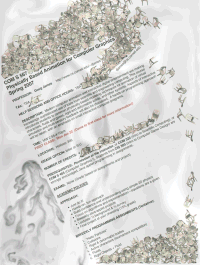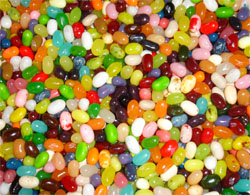- David Baraff and Andrew Witkin, Physically Based Modeling, Online SIGGRAPH 2001 Course Notes, 2001.
- An interesting historical perspective:
- Terzopoulos, D., Pltt, J., Barr, A., Zeltzer, D., Witkin,
A., and Blinn, J. 1989. Physically based
modeling: past, present, and future. In ACM SIGGRAPH 89
Panel Proceedings (Boston, Massachusetts, United States, July 31
-
August 04, 1989). SIGGRAPH '89. ACM Press, New York, NY, 191-209.

- constant, c
- position, p_j
- vectors, (p_j-p_k)
- distances, ||p_j-p_k||
- distance powers, ||p_j-p_k||^n
- dot products, (p_1-p_0)^T (p_3-p_2)
- cross products
- Example: hair bending energy derivative, E =
k*sin^2(theta/2) [handout]

- Discussed Assignment #1 Particle Systems
- Symplectic
Euler integrator (a.k.a. semi-implicit Euler)
- Videos:
- Particle Dreams by Karl Sims, 1988.
- Other classic videos:
- Evolved Virtual Creatures by Karl Sims, 1994.
- Panspermia by Karl Sims, 1990.
- Pipe Dream, 2001.
- David Baraff and Andrew Witkin, Physically Based Modeling, Online SIGGRAPH 2001 Course Notes, 2001.
Mass-Spring Particle Systems
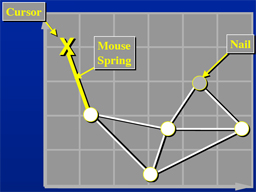
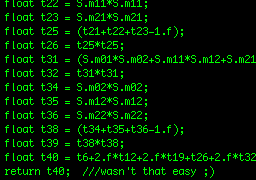
- Slides (PDF)
- Foreshadowing:
- deformation mapping
- deformation gradient
- Polar decomposition
- Newton-Schulz iteration
IMEX and other schemes
- David Baraff and Andrew Witkin, Physically Based Modeling, Online SIGGRAPH 2001 Course Notes, 2001.
- Implicit Methods (Baraff)
- Implicit-Explicit (IMEX) integration schemes:
- Ascher, Ruuth, Wetton, Implicit-Explicit Methods for Time-Dependent Partial Differential Equations, SIAM J. Num. Anal. 32, pp. 797-823, 1995.
- Bernhard Eberhardt, Olaf Etzmuß, Michael Hauth, Implicit-Explicit Schemes for Fast Animation with Particle Systems, Computer Animation and Simulation 2000, Proceedings of the EG Workshop in Interlaken, 21-22 August, 2000.
- Example: "Going implicit on damping"
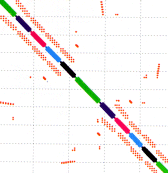
- Poisson's equation model problem
- Overview of space/time complexity results for Poisson's equation
- Iterative methods for sparse linear systems
- Matrix splitting & iterative solution
- Basic Methods:
- Jacobi
- Gauss-Seidel
- Successive overrelaxation (SOR)
- Krylov Subspace Methods
- Basic idea
- Conjugate Gradient Method
- Preconditioning
- Reference:
- James W. Demmel, Applied Numerical Linear Algebra,
SIAM Press, Philadelphia, 1997. (errata)
- Barrett et al., Templates for the Solution of Linear
Systems: Building Blocks for Iterative Methods, 2nd edition,
1994.
Feb16
Feb18
![Cloth from [Bridson et al. 2002]](images/thumb_bridson02.jpg)
- Velocity-level collision resolution
- Continuous collision detection
- 2D (point-edge, sphere-sphere), and 3D (point-face, edge-edge) tests
- Impulse resolution
- Supporting pin/trajectory constraints
- Inverse-mass matrix filtering
- Penalty forces
- Rigid cloth zones
- Robert Bridson, Ronald P. Fedkiw, John Anderson, Robust Treatment of Collisions, Contact, and Friction for Cloth Animation, ACM Transactions on Graphics, 21(3), July 2002, pp. 594-603.
- David Baraff, Andrew P. Witkin, Large Steps in Cloth Simulation, Proceedings of SIGGRAPH 98, Computer Graphics Proceedings, Annual Conference Series, July 1998, pp. 43-54.
- X. Provot, Collision and self-collision handling in cloth model dedicated to design garment. Graphics Interface, 177–89, 1997. (first introduction of rigid cloth zones)
- Robust Treatment of Simultaneous Collisions, David Harmon, Etienne Vouga, Rasmus Tamstorf, Eitan Grinspun, ACM Transactions on Graphics, 27(3), August 2008, pp. 23:1-23:4. (equality-constraint alternative to rigid cloth zones)
Mar 8
Robust Collision Processing
(a.k.a. "The Spaghetti Factory")
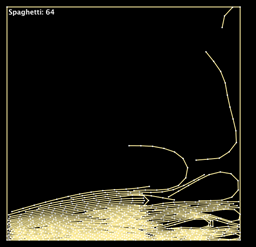
- Starter code available from CMS
![Rigid bodies in contact [Baraff notes]](images/thumb_rigidbody.png)
- Rigid body concepts (position, orientation, linear/angular
velocity, momentum, inertia, etc.)
- Contact impulses
- Example: rigid zones for cloth
- Frictionless contacts:
- Nonpenetration constraints
- Velocity-level constraints (see Baraff course notes for
accleration-level constraints)
- Linear Complementarity Problem (LCP)
- David Baraff and Andrew Witkin, Physically Based Modeling, Online SIGGRAPH 2001 Course Notes, 2001.
- (see cloth references for rigid cloth zones)
Mar02
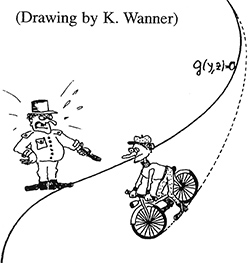
- Holonomic constraints, C(p)=0.
- Example: Bead on a wire
- Differentiating constraints w.r.t. time.
- Constraint Jacobian, J
- Lagrange multipliers, lambda, and constraint forces, J^T
lambda
- Solving for Lagrange multipliers
- Implicit constraint (and half-explicit) DAE integration
schemes
- David Baraff and Andrew Witkin, Physically Based Modeling, Online SIGGRAPH 2001 Course Notes, 2001.
- Rony Goldenthal, David Harmon, Raanan Fattal, Michel
Bercovier, Eitan Grinspun, Efficient Simulation of Inextensible Cloth,
ACM Transactions on Graphics, 26(3), July 2007, pp. 49:1-49:7.
[ACM Digital Library link]
Mar04

- Jonathan Richard Shewchuk, An Introduction to the Conjugate Gradient Method Without the Agonizing Pain, August 1994. PDF (516k, 58 pages)
Projected Gauss-Seidel Solver
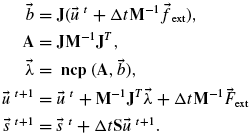
- K. Erleben, Stable,
robust, and
versatile multibody dynamics animation. Ph.D. thesis, Department of
Computer Science, University of Copenhagen, Denmark, 2005. [avi movie]
- K. Erleben, Velocity-based shock propagation for
multibody dynamics animation, ACM Trans. Graph. 26, 2, Jun.
2007. (most similar to Mar09
lecture)
Rigid Body Contact
(a.k.a. "The Jelly Bean Factory")
- See "Jelly Bean Factory" contest results
- Starter code available from CMS (soon)
Mar18
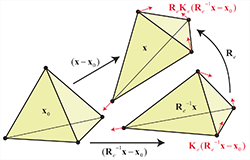
- M. Müller, M. Gross, Interactive Virtual Materials,
in Proceedings of Graphics Interface (GI 2004), pp 239-246, London,
Ontario, Canada, May 17-19, 2004. [Video]
- J. Georgii and R. Westermann, Corotated Finite Elements Made Fast and
Stable, VRIPHYS Workshop in Virtual Reality Interactions and
Physical Simulations, 2008. [PDF] [Video]
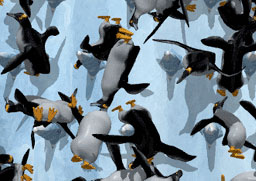
- Matthias Müller, Bruno Heidelberger, Matthias
Teschner, Markus Gross, Meshless
deformations based on shape matching, ACM Transactions on
Graphics, 24(3), August 2005, pp. 471-478. [ACM]
[PDF] [AVI]
- Alec R. Rivers, Doug L. James, FastLSM: Fast Lattice Shape Matching for Robust Real-Time Deformation, ACM Transactions on Graphics, 26(3), July 2007, pp. 82:1-82:6. [ACM] [PDF]
- Denis Steinemann, Miguel A. Otaduy, Markus Gross, Fast Adaptive Shape Matching Deformations,
ACM SIGGRAPH/Eurographics Symposium on Computer Animation, Dublin, July
7-9, 2008. [PDF] [AVI]
Apr06
![Fun with eggs! (from [Popovic et al. 2000])](images/thumb_popovic2000.png)
- Ronen Barzel , John F. Hughes , Daniel N. Wood, Plausible motion simulation for computer
graphics animation, Proceedings of the Eurographics workshop
on Computer animation and simulation '96, p.183-197, December 1996,
Poitiers, France .
- Jovan Popovic, Steven M. Seitz, Michael Erdmann, Zoran Popovic, Andrew P. Witkin, Interactive Manipulation of Rigid Body Simulations, Proceedings of ACM SIGGRAPH 2000, Computer Graphics Proceedings, Annual Conference Series, July 2000, pp. 209-218.
- Stephen Chenney, D. A. Forsyth, Sampling Plausible Solutions to Multi-Body Constraint Problems, Proceedings of ACM SIGGRAPH 2000, Computer Graphics Proceedings, Annual Conference Series, July 2000, pp. 219-228.
- Christopher D. Twigg, Doug L. James, Many-Worlds Browsing for Control of
Multibody Dynamics, ACM Transactions on Graphics, 26(3),
July 2007, pp. 14:1-14:8. [ACM] [PDF] [Software Demo]
- Christopher D. Twigg, Doug L. James, Backward Steps in Rigid Body Simulation,
ACM Transactions on Graphics, 27(3), August 2008, pp. 25:1-25:10.
[ACM] [PDF]
- C. O'Sullivan and J. Dingliana, Collisions and Perception, ACM
Trans. Graph. 20, 3 (Jul. 2001), 151-168.
Apr13

- Jos Stam, Stable Fluids, Proceedings of SIGGRAPH 99, Computer Graphics Proceedings, Annual Conference Series, August 1999, pp. 121-128. [Slides and notes]
- Ronald Fedkiw, Jos Stam, Henrik Wann Jensen, Visual Simulation of Smoke, Proceedings of ACM SIGGRAPH 2001, Computer Graphics Proceedings, Annual Conference Series, August 2001, pp. 15-22. (introduces vorticity confinement forces)
- Bridson, R., Fedkiw, R., and Muller-Fischer, M. 2006. Fluid simulation: SIGGRAPH 2006 course notes, In ACM SIGGRAPH 2006 Courses (Boston, Massachusetts, July 30 - August 03, 2006). SIGGRAPH '06. ACM Press, New York, NY, 1-87. [Slides, Notes]
- Robert Bridson, Fluid Simulation for Computer Graphics, A K Peters, 2008:
![From [Treuille et al. 2003]](images/thumb_smokeControl.png)
- Adrien Treuille, Antoine McNamara, Zoran Popović, Jos Stam, Keyframe Control of Smoke Simulations, ACM Transactions on Graphics, 22(3), July 2003, pp. 716-723. [paper] [project] [video] Graphbib page
- Antoine McNamara, Adrien Treuille, Zoran Popović, Jos Stam, Fluid control using the adjoint method, ACM Transactions on Graphics, 23(3), August 2004, pp. 449-456. [paper] [project] Graphbib page
- Raanan Fattal, Dani Lischinski, Target-driven smoke animation, ACM Transactions on Graphics, 23(3), August 2004, pp. 441-448. [paper] [project] Graphbib page
![From [Carlson et al. 2004]](images/thumb_rigidFluid.jpg)
- Mark Carlson, Peter J. Mucha, Greg Turk, Rigid Fluid: Animating the Interplay Between Rigid Bodies and Fluid, ACM Transactions on Graphics, 23(3), August 2004, pp. 377-384. [paper] [project] [graphbib] [ACM Digital Library] (a really simple way to add rigid bodies to a fluid simulation)
- William V. Baxter III, Ming C. Lin, Haptic Interaction with Fluid Media, Graphics Interface 2004, May 2004, pp. 81-88.
- Eran Guendelman, Andrew Selle, Frank Losasso, Ronald
Fedkiw, Coupling water and smoke to thin deformable
and rigid shells, ACM
SIGGRAPH 2005 Papers, July 31-August 04, 2005, Los Angeles, California.
[project]
- Nuttapong Chentanez, Tolga G. Goktekin, Bryan E. Feldman, James F. O'Brien, Simultaneous coupling of fluids and deformable bodies, Proceedings of the 2006 ACM SIGGRAPH/Eurographics symposium on Computer animation, September 02-04, 2006, Vienna, Austria. [project]
- Jeroen Molemaker, Jonathan M. Cohen, Sanjit Patel, Jun-yong Noh, Low Viscosity Flow Simulations for Animation, Symposium on Computer Animation 2008. [paper] [video (mpeg4)] [youtube]
- CUDA Car Demo / NVIDIA APEX Turbulence Sneak Peak. Interactive fluid simulation and volume rendering demo written by Jonathan M. Cohen, Sarah Tariq, and Simon Green. [youtube] [CUDA Zone]
- Robinson-Mosher, A., Shinar, T., Gretarsson, J., Su, J. and
Fedkiw, R., Two-way Coupling of Fluids to Rigid and
Deformable Solids and Shells, SIGGRAPH 2008, ACM TOG 27,
46.1-46.9 (2008). [Videos: 1,
2,
3]
Apr27

- Danny M. Kaufman, Shinjiro Sueda, Doug L. James, Dinesh K. Pai, Staggered Projections for Frictional Contact in Multibody Systems, ACM Transactions on Graphics, 27(5), December 2008, pp. 164:1-164:11.
- A good reference on convex optimization:
- Stephen Boyd and Lieven Vandenberghe, Convex Optimization, Cambridge University Press, 2004.
- Stanford lecture notes/book [PDF]
